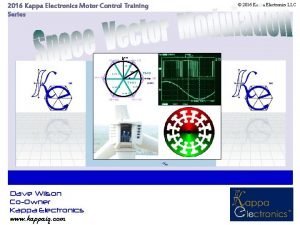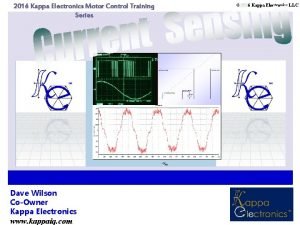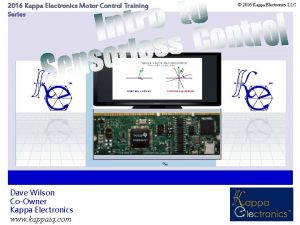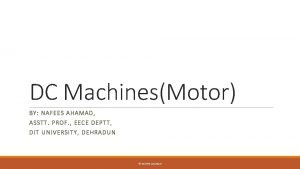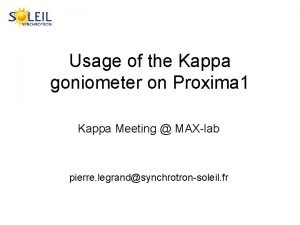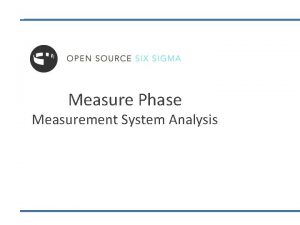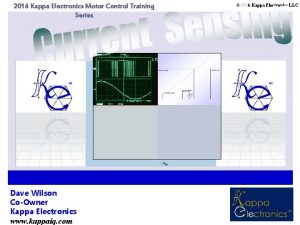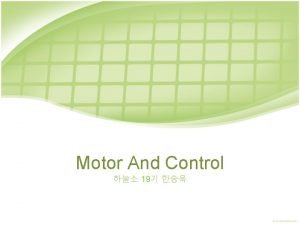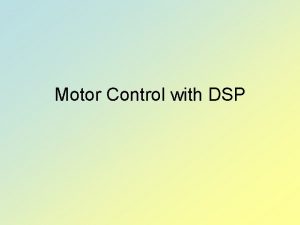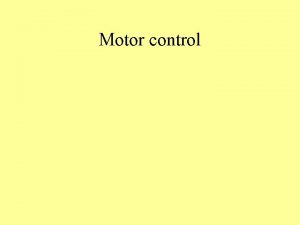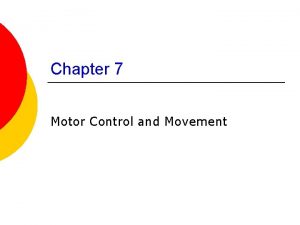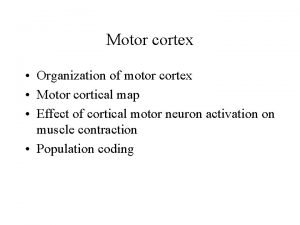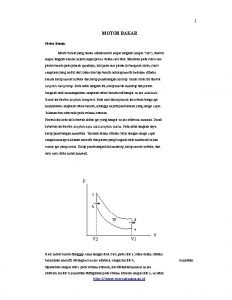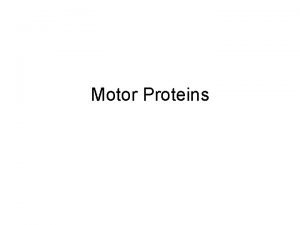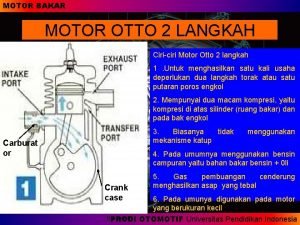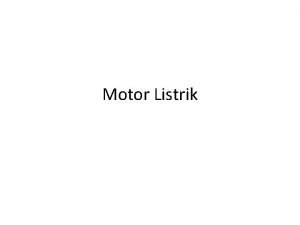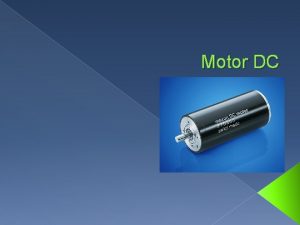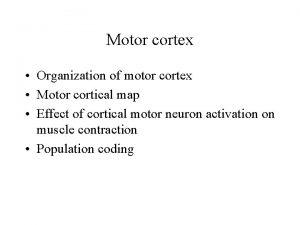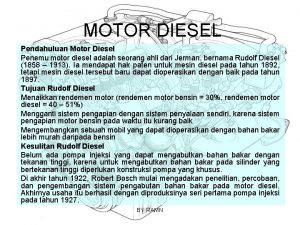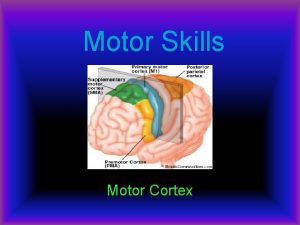2016 Kappa Electronics Motor Control Training Series 2016





























- Slides: 29

2016 Kappa Electronics Motor Control Training Series © 2016 Kappa Electronics LLC -Vth Dave Wilson Co-Owner Kappa Electronics www. kappaiq. com

Sensorless Sensored FOC P + Kappa Electronics + I Commanded iq (torque) I Reverse Clarke-Park Transform + + Vq Va Vb ∫ I θd ∫ iq id ia d/dt Forward Clarke-Park Transform ib ic Dave’s Motor Control Center Vc + - Rotor Speed ∫ P P + PMSM + - Commanded Rotor Speed + Vd Phase C Current Calculation TM Observer θd Speed Commanded id = 0 θd Shaft position sensors are VERY expensive ($1, 500 in some cases). Many applications cannot afford the cost of a shaft sensor. Keeping your motors spinning. Dave Wilson

Model Based Filtering Noise Measurement Kappa Electronics Process Σ Error feedback + - Mathematical Model of Process Σ TM Estimate Keeping your motors spinning. Dave Wilson

Tracking Filters Kappa Electronics ^ Dy correction ^ correction y + Σ β TM - α Z-1 + + Σ Integrator Better tracking is obtained when α and β are high Better filtering is obtained when α and β are low Keeping your motors spinning. Dave Wilson

The Tracking Filter…Unmasked! Kappa Electronics The tracking filter is revealed to be a simple 2 nd order IIR filter as shown below. Accumulator a+b X(n) Y(n+1) + + Delay X(n-1) TM -a 2 -a-b Y(n) Delay a-1 Keeping your motors spinning. Y(n-1) Dave Wilson

Cascaded Representation Kappa Electronics This form of the filter reveals the derivatives of the tracked variable. Measured Position Error β + Σ - TM α Z-1 + + Σ Integrator Estimated Position Estimated Velocity Estimated Acceleration Keeping your motors spinning. Dave Wilson

Tracking Filters have Phase Delay CHICAGO Kappa Electronics Feedforward input fixes this problem Keeping your motors spinning. TM Dave Wilson

Parameter Estimation with Observers By providing an additional feedforward input, the tracking filter can make better output estimates. It then takes the form of an OBSERVER. Kappa Electronics Can be designed to have zero (or near zero) estimation lag. Source: Motion Controller Employs DSP Technology, Robert van der Kruk and John Scannell, Phillips Centre for Manufacturing Technology, PCIM – September, 1988 TM α β Integrator Model of H(z) Observers are used to “observe” a quantity which is difficult to measure by mathematically modeling the system. Observers literally recreate the desired signal mathematically (great noise decoupling). The “guess” is corrected by comparison with an observable signal. Keeping your motors spinning. Dave Wilson

Observer with PI Front-end PI Controller (Beta) Kappa Electronics (Alpha) Keeping your motors spinning. TM Dave Wilson

Servo Performance with Velocity Directly from Encoder vs. Observer Kappa Electronics Keeping your motors spinning. TM Dave Wilson

Vb PMSM Va Clarke Kappa Electronics Vc Applied voltage Resistance voltage Inductance voltage Back-EMF voltage Keeping your motors spinning. TM Dave Wilson

Phase Current Model Current Estimator Block Vin alpha + + - - EMFalpha 1/Ls Kappa Electronics Rs Current Estimator Block Vin beta EMFbeta + + - 1/Ls TM - Rs Keeping your motors spinning. Dave Wilson

Compare to Actual Phase Current Vin alpha Current Estimator Block + + error + 1/Ls - Kappa Electronics EMFalpha (0) - - Rs ialpha (measured) Vin beta Current Estimator Block + + EMFbeta (0) - + 1/Ls - error TM - Rs ibeta (measured) Keeping your motors spinning. Dave Wilson

Back-EMF Observer a Vin alpha Current Estimator Block + + error + - - EMFalpha 1/Ls - PI Kappa Electronics Rs ialpha (measured) Vin beta EMFbeta Current Estimator Block + + - 1/Ls - error + - Rs PI b TM ibeta (measured) Use observable parameter (current) to estimate unobservable parameter (back-EMF). Keeping your motors spinning. Dave Wilson

Kappa Electronics Keeping your motors spinning. TM Dave Wilson

Actual Back-EMF Estimated Back-EMF Kappa Electronics TM LTSpice Sampling frequency = 10 KHz Keeping your motors spinning. Dave Wilson

Finding the Angle Kappa Electronics TM Requires floating point math Must take inverse tangent function Singularity when EMFalpla(t) = 0 Takes a long time to calculate Keeping your motors spinning. Dave Wilson

Vin alpha EMFalpha Current Estimator Block error + - PI Kappa Electronics ialpha (measured) sin x - Angle Demodulator + k 1 sin(q -qest) TM + + k 2 x cos EMFbeta Vin beta sin(q)cos(qest)-cos(q)sin(qest) = sin(q -qest) Current Estimator Block error + - ibeta PI Keeping your motors spinning. (measured) Dave Wilson

Sliding Mode EMF Observer Kappa Electronics Iα Vα + - 1/Ls ^ Iα + + - - + Iαerror Zα TM SGN Kslide - Rs/Ls Zα LPF EMFα “A Position and Velocity Sensorless Control of Brushless DC Motors Using an Adaptive Sliding Observer”, Takeshi Furuashi, Somboon Sangwongwanich, Shigeru Okuma, 1990 IEEE Proceedings, 087942 -600 -4/90/1100 -1188, pp. 1188 -1192. Keeping your motors spinning. Dave Wilson

Zero-Speed Saliency Tracking Observer P I regulator results in steady state value servoing to zero qerr = 0 Kappa Electronics High Frequency Current Measurement Demodulator LPF High Frequency Voltage Injection (about 500 Hz) q axis st) (e xis qa s d axi t) s si (e x da θ actual P I Zq Zd LPF TM θerr Disadvantages: Only works on motors with a strong saliency signal. Saliency graph shifts when the motor is loaded. Works at low speeds, but falls apart at high speeds. Keeping your motors spinning. Dave Wilson

Direct Field Orientation (Sensorless Control) Kappa Electronics Knowledge of slip not needed Stator flux TM Rotor flux Superscript “s” indicates stationary frame quantity Equation for rotor flux includes leakage inductances in motor. If stator and rotor leakage inductances are zero, you will find that the equation for rotor flux yields the stator flux. Source: Power Electronics and Variable Frequency Drives, Technology and Applications, edited by Bimal Bose, Chapter 5, by Robert Lorenz, Tom Lipo, and Don Novotny, IEEE Press, 1997 Keeping your motors spinning. Dave Wilson

Rotor Flux Calculator Kappa Electronics Here’s the problem at low speeds TM Superscript “s” indicates stationary frame quantity Two problems plague the low speed operation: Voltage amplitudes are lower, resulting in poor signal-to-noise ratios. Integrator gain opens up at low frequencies. Drifts and offsets quickly become a problem. Source: Power Electronics and Variable Frequency Drives, Technology and Applications, edited by Bimal Bose, Chapter 5, by Robert Lorenz, Tom Lipo, and Don Novotny, IEEE Press, 1997 Keeping your motors spinning. Dave Wilson

Put It All Together Kappa Electronics Note: Still in stationary frame TM Stationary Frame Synchronous Frame Source: Zero-Speed Tacho-less I. M. Torque Control: Simply a Matter of Stator Voltage Integration, by K. D. Hurst, T. G. Habetler, G. Griva F. Profumo, IEEE paper, 1997 Keeping your motors spinning. Dave Wilson

ACIM Stator Flux Referenced FOC Kappa Electronics roto r cu rren t stator q axis roto TM stator flux axis r flu x ax is rqa xis (easily measured)! roto However, D-axis stator current no longer independently controls flux (i. e. , the axes are now COUPLED). Dave Wilson Keeping your motors spinning.

Stator Field Referenced Controller with Decoupling Kappa Electronics TM Source: Vector Control and Dynamics of AC Drives, by Don Novotny and Tom Lipo, Oxford University Press, 2000 Keeping your motors spinning. Dave Wilson

Direct Torque Control Stator flux referenced control technique Kappa Electronics Sensorless Does not require reference frame transformations. Torque is controlled DIRECTLY in the stationary TM frame. Exploits unique attributes of Space Vector Modulation. Torque can be changed rapidly by quickly applying the appropriate space vector voltage. Keeping your motors spinning. Dave Wilson

DTC: A Peek under the Hood Vector Selector Commanded Torque Hysteretic Band increase decrease - + Dave’s Motor Control Center SVM Torque Calculator Kappa Electronics Commanded Flux + - Stator Flux Calculator Keeping your motors spinning. TM Dave Wilson

DTC Zones on SVM Graph Kappa Electronics V 2 (010) V 3 (011) Zone 2 Zone 3 TM Zone 1 V 6 (110) V 1 (001) Zone 4 Zone 6 Zone 5 V 4 (100) V 5 (101) Flux vector zone boundaries are offset by 30° from SVM vectors Keeping your motors spinning. Dave Wilson

Voltage Vector Selection Table for Zone 1 Kappa Electronics Vector component of V 2 (010) which produces positive torque. V 3 (011) Zone 2 Zone 1 Vector Table Zone 3 Flux Increase V 3 Increase Decrease V 5 Decrease Increase V 2 Decrease V 4 Zone 1 V 6 (110) V 1 (001) Zone 4 Zone 6 Zone 5 V 4 (100) V 5 (101) Voltage TM Torque Vector Each zone has a different vector selection table. Keeping your motors spinning. Dave Wilson
 Kappa electronics
Kappa electronics Kappa electronics
Kappa electronics Kapa electronics
Kapa electronics Series parallel control of electric traction motor
Series parallel control of electric traction motor Digital motor electronics bmw
Digital motor electronics bmw Uma analise criteriosa do desempenho de usain bolt
Uma analise criteriosa do desempenho de usain bolt Pony motor starting synchronous motor
Pony motor starting synchronous motor A motor unit consists of
A motor unit consists of Principle of operation of synchronous motor
Principle of operation of synchronous motor Motor parts name
Motor parts name Ee 216
Ee 216 Torque speed characteristics of dc series motor
Torque speed characteristics of dc series motor Maclaurin series vs taylor series
Maclaurin series vs taylor series Balmer series lyman series
Balmer series lyman series Serie de taylor
Serie de taylor Maclaurin series vs taylor series
Maclaurin series vs taylor series P series ibm
P series ibm Series series feedback amplifier
Series series feedback amplifier Series aiding and series opposing
Series aiding and series opposing Sum of infinite series
Sum of infinite series Mip certification zeta phi beta
Mip certification zeta phi beta Kappa goniometer
Kappa goniometer Kappa termodynamika
Kappa termodynamika Measurement system analysis
Measurement system analysis Inter-rater reliability 中文
Inter-rater reliability 中文 Southwest province kappa psi
Southwest province kappa psi Southwestern province kappa alpha psi
Southwestern province kappa alpha psi Kappa alpha psi life membership card
Kappa alpha psi life membership card Kappa alpha psi moratorium
Kappa alpha psi moratorium Alpha kappa alpha membership intake process manual
Alpha kappa alpha membership intake process manual
